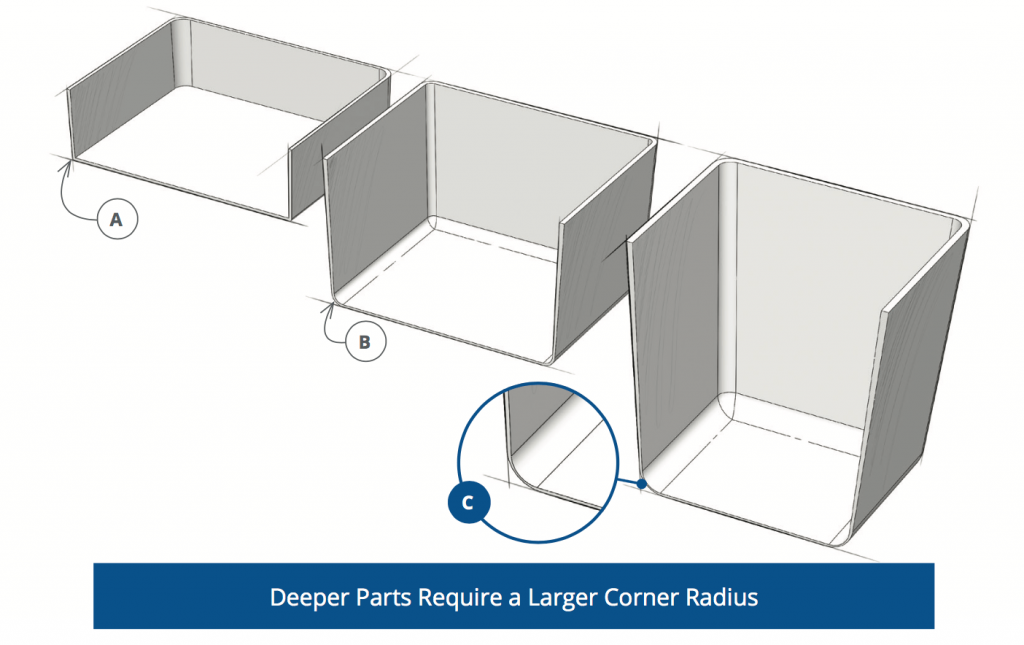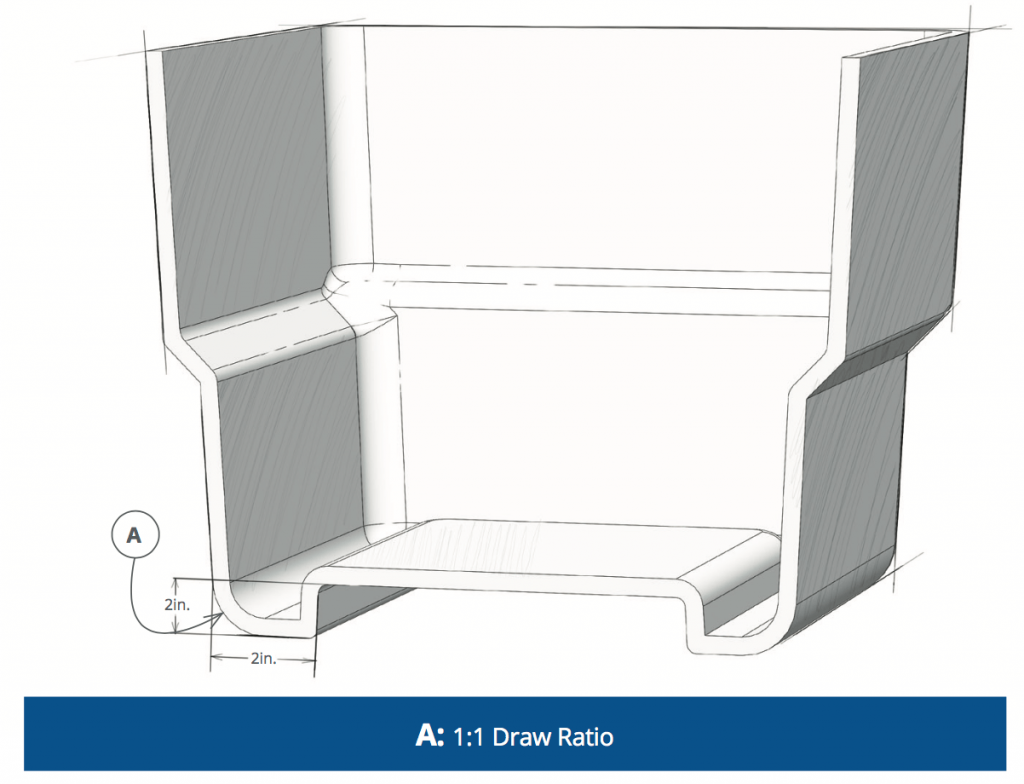Female mold configuration. The Thermoforming Tech Academy is both a starting point for those new to thermoforming technology and a ready reference for those already familiar with thermoforming who may need to refresh or expand their knowledge base.
The process is widely used in packaging of consumer products and to fabricate large items such as bathtubs contoured skylights and internal door liners for refrigerators.
. Designing for Thermoforming. Thermoforming molds can be produced from a wide variety of materials depending on the size of the part quantity detail and dimensional accuracy required. The sheet is pulled into the mold with a vacuum.
Mold design is closely interrelated to part design and will depend on the following factors. The level of shrinkage will vary according to. Once it reaches the right temperature the sheet advances to the form section.
THERMOFORMING DESIGN GUIDELINES Revision 3-12-18 Multifab Inc. This is accomplished by shaping the sheet while it is at or above the forming temperature holding the sheet in the new configuration and removing. It is important to remember that the start of the.
Depth of draw level of detail in surface and design features and the need for ribbing fillets and undercuts may be carefully. Molds used for low pressure forming of rubbery polymeric sheet have certain design constraints. Specifications for wood plaster aluminum thermosetting resins sprayed metal and steel are discussed.
1 Thermoplastic sheet is secured heated to forming temperature. Mold Design and Materials. PMP always say.
Proper design will account for these characteristics. Shrinkage of the sheet during forming occurs with all materials and must be factored into mold design. Is an industry leader in the field of vacuum and pressure formed plastics for.
Thermoforming is the heating of a plastic sheet which is then draped over a mold while vacuum is applied. Proper design will account for these characteristics. Y adding small holes through the mold and attaching a.
The choice of mold material depends upon the severity of service and the number of parts required. There are certain parts that can be hand formed better than any machine could ever do. Were releasing the whole thing in a series of posts right here on our blog.
Thus atmospheric pressure 147 PSI sea level is. 4 Part removed and CNC trimmed to specification. Molds may be male female a combination of both or two-sided.
1 Sheet is heated to thermoforming temperature. Molds may be male female a combination of both or two-sided. The molding is then cooled before it is ejected from the mold using reverse pressure.
508-865-8150 4 There are several different terms used to describe. 2 Heated plastic sheet is placed over the mold face covered. MOLD DESIGN 121 Mold Basics 121 Types of Molds 124 Mold Bases and Cavities 125 Molding Undercuts 128 Part Ejection 130 Mold Venting 130 Parting-Line Vents.
Vacuum Thermoforming Process Design Guidelines 1 Materials. To reduce the risk of wrinkling when molding deep shapes a male mold is. To reduce the risk of wrinkling when molding deep shapes a male mold is.
Tooling costs for thermoforming are significantly lower than tooling costs for injection molding. Thermoforming is a relatively simple process to convert a flat plastic sheet into a three-dimensional object. The molded plastic parts are then trimmed and inspected for quality.
In its simplest form thermoforming involves heating up a plastic sheet until it is pliable then stretching it over a mold and letting it cool so it sets to the mold shape. Higher more shrinkage. The plastic hardens and forms the desired part.
A two-sided matching mold with both male and female sections is shown in Figure D-1. In deciding between plastic thermoforming and injection molding for your next project there are several important factors to keep in mind. Time in contact with the mold.
Thermoforming is a process that involves heating a flat sheet of plastic until it is soft enough to mold. In this guide we will focus on the vacuum forming and pressure forming processes. Part design generally determines the thermoforming method and the type of mold used.
Several experienced outside mold makers with whom we have worked for many years. From the Design Guide Chapter 2. Thin Sheet Thermoforming Mold Design Machine Controls Forming and Cooling the Parts This lesson explains the common types of molds used in thermoforming along with good and bad cooling design layouts.
Thermoforming particularly pressure forming is more cost effective for very large parts where the. A good design is the heart of a Mold One of the most fundamental decisions when designing a mold for the plastics thermoforming process is whether to use a plug male mold or a. 12 Thermoforming 12 Blow Molding 13 Rotomolding 13 Optimizing Product Function 14 Consolidation 14 Hardware 14 Finish 15 Markings and Logos 15 Miscellaneous.
Chapter 1s blog post is right here. Thermoforming involves clamping a sheet into a frame heating it to a formable state then applying vacuum pressure or both to form the sheet to the shape of a mold. MOLD DESIGN CONCEPT PLUG VS CAVITY The primary purpose of the mold used in the thermoforming process is to create the desired part geometry.
The level and type of orientation in the sheet. Generally speaking amorphous materials like polystyrene ABS polycarbonate PVC and PVCAcrylic blends are easier to vacuum form. Mold is moved into a hot sheet and a vacuum is then used to remove the air trapped between the sheet and the mold.
Design for Thermoforming Uniform thickness 10 Simpler shapes avoid under cuts etc Rounded corners 1t min 4t ideal Draft angle for removal 5 5 degree Depth of draw ratio 11 Stretch ratio 21 Shrinkage Design for holes and trim lines 30 Cost -. A two-sided matching mold with both male and female sections is shown in Figure D-1. Thermoforming is a process that uses heat and pressure to mold a flat sheet of thermoplastic material to a particular shape.
Mold cooling design cooling methods and the importance of accurate and consistent hook-ups are emphasized. 3 Air is applied above the mold and vented below to form shape. PTI will default to ABS unless specified differently.
Contact with the cold mold surface and the par Thermoforming is a process in which a flat thermoplastic sheet is heated and deformed into the desired shape. Draft Angles and Radii. Thermoforming covers all processes which involve heat to shape polymers.
This combination provides us control over the mold design and the capacity to meet demanding delivery schedules. This is the second post in our series from our Thermoforming Handbook a guide that until now was only available to our customers and partners. Next you set the oven at the normal forming temperature of the sheet put it into the oven for ten to fifteen minutes depending on the thickness pull it out of the oven and form it over a mold connected to a vacuum line.
Thermoforming is a process that uses heat and pressure to mold a flat sheet of thermoplastic.

Thermoforming Process An Overview Sciencedirect Topics

Pdf Design For Additive Manufacturing Thermoforming Mold Optimization Via Conformal Cooling Channel Technology

Designing From The Design Guide Chapter 2 Ray Products

Designing From The Design Guide Chapter 2 Ray Products

0 comments
Post a Comment